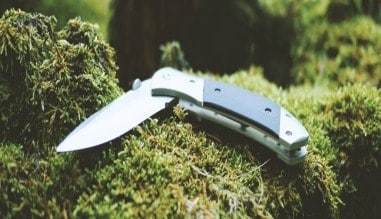
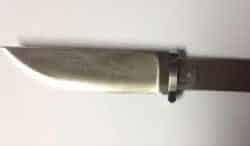 No survivalist’s kit is complete without at least one knife, and there’s always an open space in the collection for just one more perfect specimen. (I know many who refuse to leave the house without theirs: When going hiking or camping, you’ll almost always have a use for one.) A knife is the one thing you’d rather have and not need.
No survivalist’s kit is complete without at least one knife, and there’s always an open space in the collection for just one more perfect specimen. (I know many who refuse to leave the house without theirs: When going hiking or camping, you’ll almost always have a use for one.) A knife is the one thing you’d rather have and not need.
By Alex Coyne, a contributing author of Survival Cache & SHTFBlog
Here’s what you should know about buying, using, maintaining and owning your knives…
1. You should never buy cheap.
Aron Ralston, better known as the subject of ‘127 Hours’, was forced to amputate his own arm after getting trapped in a canyon. After the event, he stated that the knife he had bought was nothing more than a standard cheap gas-station pocket knife – dull, at that. Don’t buy cheap knives. Always buy the best you can possibly afford: Something that’s going to last you a long time, something that’s not going to rust, bend or break. You never know what you’re going to need it for, and that’s a perfect example.
2. Know what to look at for quality.
 Just what makes a quality knife, then? Consider brand-name manufacturers rather than something you’ve never heard of that costs half the price – sadly, that is a good rule of thumb if you’re going to need your knife for life-and-death. Generally, buy something that comes recommended: Ask around. Try several in your hand before you buy one. You want to purchase a knife that feels right – something that’s too small or too big for your hands is going to be more of a danger and annoyance to you in the long-run.
Just what makes a quality knife, then? Consider brand-name manufacturers rather than something you’ve never heard of that costs half the price – sadly, that is a good rule of thumb if you’re going to need your knife for life-and-death. Generally, buy something that comes recommended: Ask around. Try several in your hand before you buy one. You want to purchase a knife that feels right – something that’s too small or too big for your hands is going to be more of a danger and annoyance to you in the long-run.
3. Flashy is not always better.
A lot of people pick a flashy blade for their first (or carry-on) for no other reason than… It looks flashy. Don’t do this. Buying a knife because it looks flashy and cool assumes you’re going to have a situation come up where you’re going to want to flash it. (That, if you’ve seen anyone come out of a knife fight recently, is a terrible idea.) Buy a knife for practicality, never for show. (If you want to buy a piece simply for its beauty, that’s fine, but in the case it goes!)
4. Know the laws about knives in your state.
Laws on knives (and the concealment thereof) vary by state and country: Familiarize yourself with what you’re legally allowed to carry (especially in terms of blade length) and how you’re allowed to carry it before you take your knife out on the road. It can land you in far more trouble than it’s worth.
5. Always handle your knife with care.
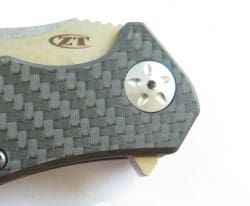 Knives are sharp; if not, they should be sharpened accordingly. Handle your knife with care (always!) and teach anyone you give a knife to as a gift to do the same. There have been far too many accidents involving knives, and we don’t want to be responsible for any more. (Note: When storing knives in your pocket, make sure that it’s one that won’t fly open and stab you in the leg by accident.)
Knives are sharp; if not, they should be sharpened accordingly. Handle your knife with care (always!) and teach anyone you give a knife to as a gift to do the same. There have been far too many accidents involving knives, and we don’t want to be responsible for any more. (Note: When storing knives in your pocket, make sure that it’s one that won’t fly open and stab you in the leg by accident.)
6. Knives can be an heirloom; consider a customized piece.
Customized pieces are available online from many excellent, specialized knifemakers. Consider this as a long-term goal, especially if you’re a keen collector or would like to pass something like this down.
7. There’s a knife for almost everything.
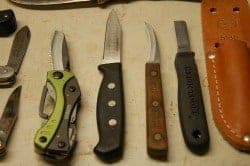 Ask yourself what you’re going to need from your knife: Is it something exclusively for preparing food when camping? Is it something for taking plant samples? Are you going diving and need a good diving knife to take along? Do you need a knife with a built-in flashlight or compass? (At this point, you might have realized that there’s a knife for almost everything and that you might need to get several to fit your needs.)
Ask yourself what you’re going to need from your knife: Is it something exclusively for preparing food when camping? Is it something for taking plant samples? Are you going diving and need a good diving knife to take along? Do you need a knife with a built-in flashlight or compass? (At this point, you might have realized that there’s a knife for almost everything and that you might need to get several to fit your needs.)
8. Learn how to sharpen a knife properly.
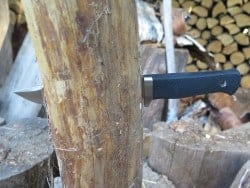 Sharpening your own knives is a skill that both comes with time and is best practiced on one of the cheaper knives (trust us on that!). If you don’t yet trust your own hands, have your knives sharpened professionally – it’s not as expensive as you’d imagine and it’s much better than ruining your grandad’s favourite hunting knife. For those who want to learn how to do it themselves, there are great guides on YouTube, like How to Sharpen Kitchen Knives and How to Sharpen a Knife with a Flat Stone, or you can take a look on Amazon.com for knife sharpeners.
Sharpening your own knives is a skill that both comes with time and is best practiced on one of the cheaper knives (trust us on that!). If you don’t yet trust your own hands, have your knives sharpened professionally – it’s not as expensive as you’d imagine and it’s much better than ruining your grandad’s favourite hunting knife. For those who want to learn how to do it themselves, there are great guides on YouTube, like How to Sharpen Kitchen Knives and How to Sharpen a Knife with a Flat Stone, or you can take a look on Amazon.com for knife sharpeners.
9. What knives can and can’t do.
Never over-exert a knife: Know what kind of pressure your knife can handle. I’ve seen people try to do excessively stupid things with their knives, and well, put simply… You really shouldn’t.
10. The danger with knife-fighting.
Knife-fighting is an art unto itself, and not one that should be practiced lightly. Ever. (Open up your search engine and look up “injuries from a knife fight” if you’ve got the stomach for it; your entire perspective on knife-fighting should change right about there). If you want to learn how to fight with a knife (or take a knife off of someone in self-defense), your best bet is to take classes from a professional in the field. (Anything, and we mean anything else is bound to lead to serious injury.)
11. Knife-throwing: The cool stuff.
You might want to learn knife-throwing as a way to show off your skills, improve your dexterity or simply demonstrate that you can be bad-ass with a knife. It goes without saying that safety applies (never practice this near children, animals, other humans; anything you can hit that you shouldn’t, basically), never indoors (no matter what you’ve seen on tv) and always with proper knives (not all knives are throwing knives). There are some great lessons available on YouTube, check out these from Tim Rosanelli for starters.
12. Using knives in the kitchen, too.
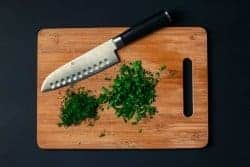 Kitchen knives deserve a special mention, as you’re going to want special knives for food preparation. Chef’s knives can be expensive, but they are guaranteed to last a lifetime if taken care of properly. Again, there are several varieties so you should shop around: From stainless steel to ceramic. There are also paring knives, scaling knives and a range of others, each suiting your individual needs.
Kitchen knives deserve a special mention, as you’re going to want special knives for food preparation. Chef’s knives can be expensive, but they are guaranteed to last a lifetime if taken care of properly. Again, there are several varieties so you should shop around: From stainless steel to ceramic. There are also paring knives, scaling knives and a range of others, each suiting your individual needs.
Use the comments to tell us about your favourite knife or some handy skills you’ve picked up over the years.
Visit Sponsors of SurvivalCache.com
from SurvivalCache http://survivalcache.com/lets-talk-knives-12-things-you-should-know/


No comments:
Post a Comment